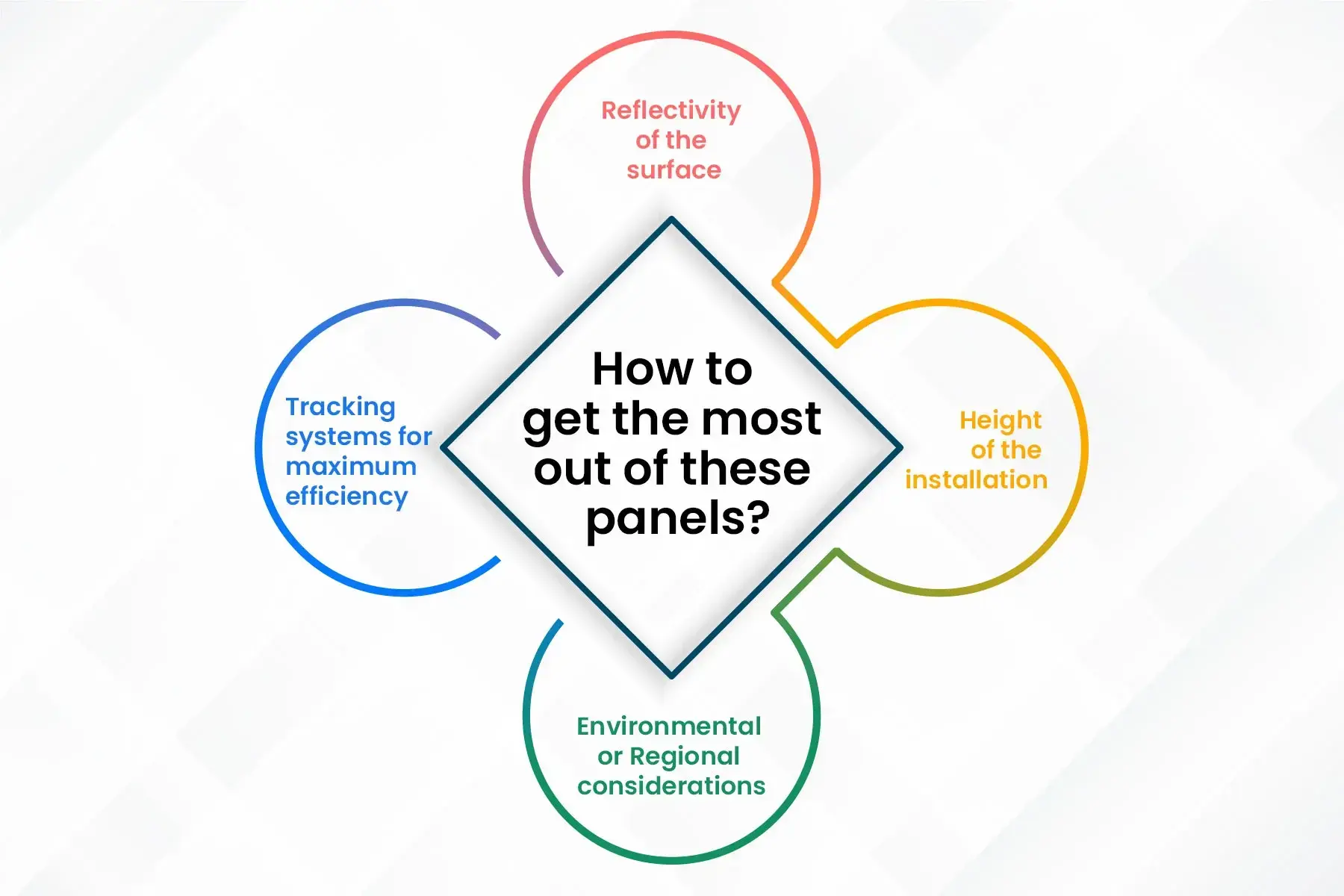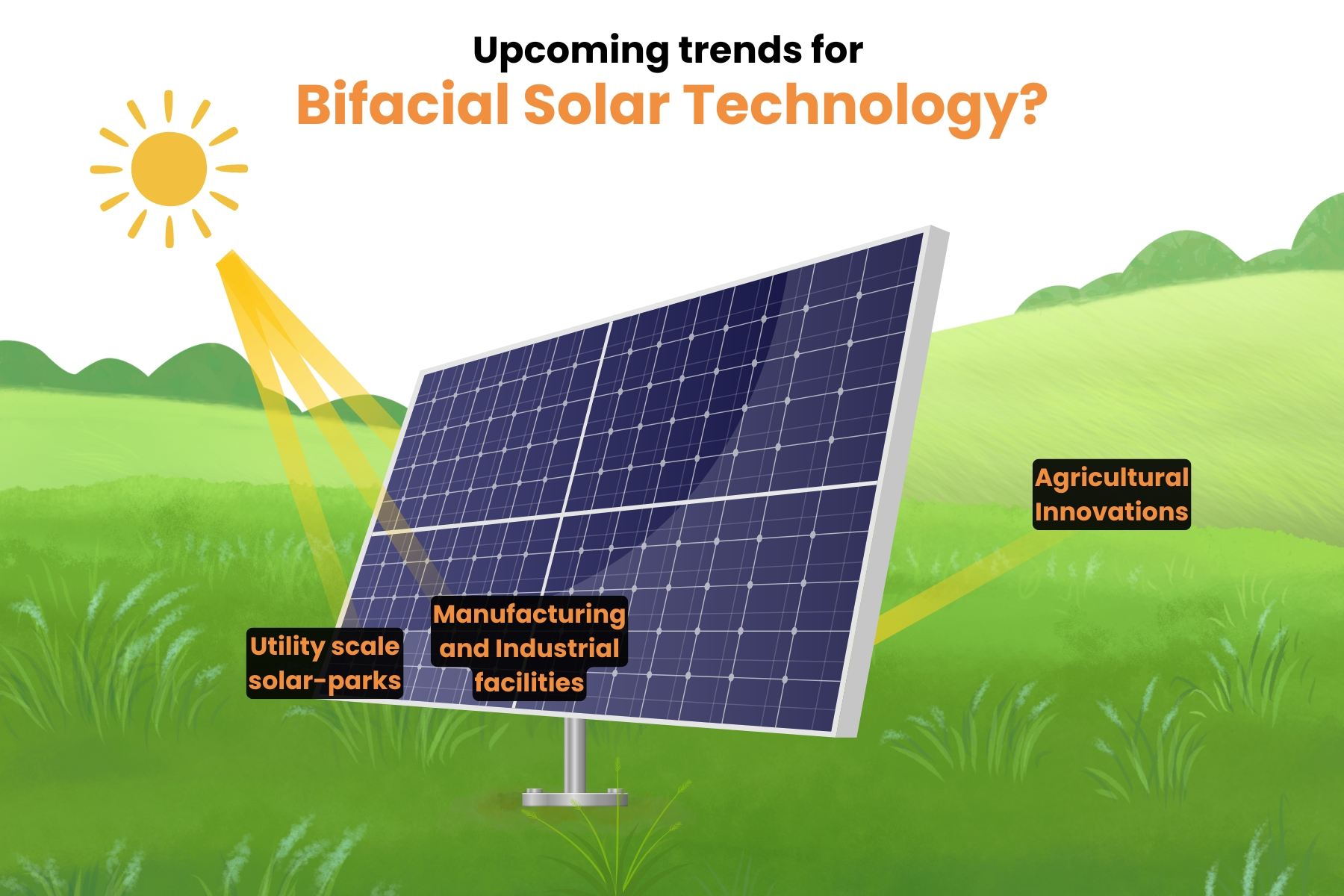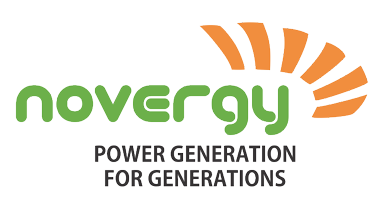1. Introduction to Bifacial Solar Panels?
Bifacial solar panels, as the name suggests, are bi-faced panels that absorb solar power from both ends. First, they collect direct sunlight and convert it to electricity, and then the other end collects reflected sunlight from the earth and converts it into electricity.
They are unlike conventional solar panels, which only collect sunlight from one end. This means that bifacial solar has the dual functionality of generating electricity without requiring any additional real estate.
Additionally to their efficiency, bifacial panels are specially made for their durability. Their dual-glass or transparent design helps prevent natural challenges like hail or strong winds. Businesses catering to higher energy production can benefit from the unique combination of reliability and performance that bifacial solar panels offer.
2. Working of Bifacial solar panels
By absorbing sunlight from both sides—direct sunlight on the front and reflected sunlight on the rear side. This collection of albedo light is a unique feature that makes bifacial solar panels stand out from the competition.
It’s a straightforward technology yet can be said to be smart and unique. The front end converts light into electricity using photovoltaic (PV) cells, while the rear end uses transparent or dual-glass layers, which allow it to collect the reflected light rays and generate electricity.
The additional energy produced by the rear side depends upon the reflectivity of the surface; the more reflective a surface is, the more energy will be produced.
These effective designs of these panels are specially given for businesses that are looking to increase their power generation, and it makes companies think about adopting those panels.
3. Why are businesses turning into bifacial modules?
Because bifacial solar panels are more likely to adopt various installation needs of businesses, generate more energy, and last longer, that’s why businesses are drastically shifting toward these panels and upgrading themselves according to the modern era.
One more key factor that makes them unique and adaptable is their efficiency. They comparatively produce 30% more electricity than the traditional monofacial panels. However, the percentage may vary depending on the various reflecting surfaces.
Reflective surfaces like gravel or snow can enhance productivity, while surfaces of grass and oil can also decrease power generation.
4. Are bifacial panels widely used across various industries?
Bifacial solar panels can be widely adopted across various industries. From commercial building rooftops to solar parks, their dual energy production capabilities make them versatile and suitable for different industrial applications. Here are the different uses of bifacial solar modules:
-
Solar Parks
Bifacial solar panels dominate solar parks by maximizing energy production within a limited land area. Their efficiency increases even more when installed over highly reflective surfaces like sand or white gravel. This makes businesses pick up these panels as their ideal choice for large-scale renewable energy projects.
-
Commercial and Industrial Rooftops
Nowadays, commercial buildings like factories, warehouses, and office buildings are also adopting these panels after looking into their capability of higher energy production by occupying comparatively little real estate.
-
Parking Canopies
Using bifacial solar panels in parking canopies is one of the innovative ideas. They provide dual benefits of parking the cars as well as generating electricity from both ends. This concept is often used in shopping malls, office complexes, and public spaces.
- Agricultural Solar projects
Bifacial panels are presently being used in multiple agricultural solar projects, power irrigation systems, and other equipment.
The high installations of these panels help farmers to continue cultivating crops with the help of renewable energy.
5. How to get the most out of these panels?

If businesses look to maximize the capability of bifacial solar panels, they need to focus on a few performance-increasing factors. The panels provide their best services when installed, along with the right environment and installation setup.
Here are some performance-increasing factors to ensure optimal energy output:
- Reflectivity of the surface
If the reflectivity of the surface is kept in mind while installing these panels, they can provide maximum performance as the surface will reflect maximum sunlight to the rear side of the panel, hence generating the maximum amount of electricity.
On the other side, if the surfaces are not very reflective, like oil, asphalt, or darker surfaces, it will result in minimum energy production.
- Height of the installation
The height of the installation also matters to get the most out of the bifacial solar panels. This makes more light exposed to the rear side, hence generating more electricity.
The optimal height for installing a bifacial solar panel is about 1-1.5 meters off the ground to get more exposure of the reflected light to the rear side.
-
Environmental or Regional considerations
One of the most important factors to be considered while installing bifacial panels is that it influences the panels and affects their productivity.
For example, coastal areas near water bodies increase the reflection due to the highly reflective surface, resulting in more energy production. Whereas dark-colored or non-reflective surfaces like asphalt or black soil reduce the bouncing back of sunlight.
-
Tracking systems for maximum efficiency
Installing tracking systems that adjust according to the movement of the sun can multiply the efficiency of bifacial solar systems.
According to studies, installing bifacial panels with solar tracking systems can improve energy production by up to 25%.
6. Dollars and Sense: Financial Benefits for Businesses
As bifacial solar panels generate comparatively more energy per panel, they are more likely to be cost-effective and improve return on investment (ROI).
Here are some financial benefits of a bifacial PV module :
-
Low energy bills
Bifacial modules reduce the efficiency of grid electricity and fulfill the needs of businesses of high energy demand at a very low cost.
Over a short period, the initial investment gets breakeven and the panels make the investment even more worth it.
-
Low cost per watt
The average per-watt cost decreases due to the capacity to generate more electricity per unit area than the traditional panels. Solar bifacials are very helpful in large-scale installations and add up to a huge amount of financial gains.
-
Access to government incentives
There are schemes offering benefits to businesses adopting renewable energy. These benefits include tax benefits, performance-based incentives, and subsidies.
The government also purchases the extra renewable energy production from the businesses which might contribute to a big financial benefit for the corporations.
7. How bifacial solar panels are supporting a sustainable future?
Moving towards sustainable energy with bifacial panels is an economic business model and more than just an energy solution. Their higher durability and efficiency help businesses to align with their sustainable goals.
Here are some ways how businesses align with their environmental goals with bifacial panels:
-
Lower carbon footprints
These panels generate more energy per unit compared to traditional panels i.e., businesses can reduce their dependence on fossil fuels for energy and reduce CO2, CO, and Methane, like harmful gases significantly.
- Push to achieve renewable energy goals
The bifacial module aligns with the sustainable goals of corporates and pushes towards net-zero emissions. Sectors like manufacturing, logistics, transportation, etc. have the potential to reduce their carbon emissions on a huge scale by adopting bifacial solar panels.
-
Enhance corporate reputation and future-proof investment
Businesses that are adopting renewable sources for energy needs have the maximum potential to increase their reputation in the corporate world.
Businesses that are adopting renewable energy have a reputation among their stakeholders and customers due to their environmentally friendly approach.
This makes sure that the existing & future investors have high confidence in them because they have a very cost-effective solution to their high energy needs.
8. Upcoming trends for Bifacial Solar Technology?

As the world is moving towards renewable energy sources, Businesses and the corporate sector are also adopting these options very rapidly.
Here are some trends that we might see shortly:
- Utility-scale solar-parks
Bifacial solar panels are largely adopted in utility-scale solar parks. Many solar producers choose bifacial technology because of their capacity to produce 30% more electricity due to their dual-sided energy production ability.
-
Manufacturing and Industrial facilities
Those industries which are having very high energy needs are rapidly shifting towards bifacial energy panels to reduce their energy cost without compromising energy availability.
- Agricultural Innovations
In the present modern era, agricultural innovations are at their peak especially to cater to the needs of farmers for power irrigation and running heavy equipment like generators, etc.
Installing bifacial solar panels on an optimum height can produce 30% more renewable energy and can run all the heavy equipment.
9. General Questions Answered: What Businesses need to Know
Despite their benefits, several questions need to be answered before installing these panels. Here are some of the questions:
-
Are bifacial panels worth their high upfront Investment?
Bifacial panels provide a long-term return on investment (ROI) despite their high upfront costs. In the long run, they also minimize the cost of energy needs and generate about 30% additional energy.
- Specific conditions needed for their efficient working?
Bifacial solar panels work more efficiently on high-reflective surfaces such as sand, gravel, or snow. However, they can still work efficiently if installed with proper elevation and tilt angle.
-
Are they Suitable for small businesses or startups?
Although bifacial module is mostly adopted for large industries they are beneficial for small-scale businesses because they provide energy independence and reduce operational costs.
- What maintenance is required for bifacial solar panels?
These panels generally require the same level of maintenance as traditional panels.
For example: cleaning both ends regularly, protecting from dust, debris, or covering from vegetation to improve overall efficiency.
-
Can excess energy be sold back to the grid?
Businesses can sell the surplus energy to the grid which further helps them improve the financial viability of installing solar technology.
10. Summary: The Business Case for Bifacial Panels
As you have gone through the blog, you read about the multiple benefits of the bifacial module of solar panels.
You read about the use cases of solar bifacial modules among different industries from manufacturing to the agriculture sector and how they are changing the overall scenario of generating renewable energy.
You have also gone through the upcoming trends how they are providing financial benefit to the corporate sector and how we can utilize them to gain the maximum energy benefits.
Overall, bifacial solar panels are the changing scenario of the renewable energy sector.

